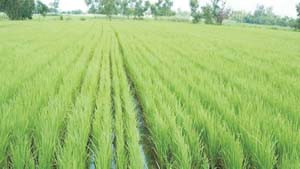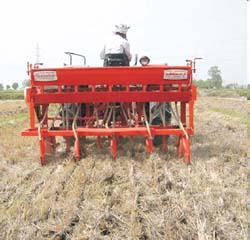 This paper by the International Food Policy Research Institute (IFPRI) reviews the success of zero-tillage wheat in the rice-wheat systems of the Indo-Gangetic Plains. Diffusion of the zero-tillage technology increased in the last decade, particularly in northwest India. In 2008, in India alone, the aggregate area in zero- or reduced- tillage wheat amounted to 1.76 million hectares, and it was used by 620,000 farmers.
This paper by the International Food Policy Research Institute (IFPRI) reviews the success of zero-tillage wheat in the rice-wheat systems of the Indo-Gangetic Plains. Diffusion of the zero-tillage technology increased in the last decade, particularly in northwest India. In 2008, in India alone, the aggregate area in zero- or reduced- tillage wheat amounted to 1.76 million hectares, and it was used by 620,000 farmers.
Zero-tillage wheat allows for a drastic reduction in tillage intensity, resulting in significant cost savings as well as potential gains in wheat yield through earlier planting of wheat. Wheat farmers who adopted zero tillage could enhance their farm income by about US$100 per hectare. The cost-saving effect alone makes zero tillage profitable and is the main driver behind its spread.
The potential environmental benefits of zero tillage have yet to be fully realized and imply tackling the challenge of reducing tillage for the rice crop that follows wheat, retaining crop residues as mulch, and diversification of crops. Equity also poses a challenge: there is a need to extend the gains more rigorously to the less endowed areas and farmers.
Zero tillage’s impact has been achieved through an intervention that has proven privately attractive; an enabling process that combined elements of persistence, flexibility, inclusiveness, and facilitation; and a context that implied the need for change. To replicate and extend this success, viable and dynamic innovation systems should be developed that can deliver and adapt interventions such as zero tillage. Addressing the existing knowledge gaps regarding zero tillage’s socioeconomic, livelihood, and environmental impacts would enhance the ability to outscale in a cost-effective, equitable, and sustainable manner.
combined elements of persistence, flexibility, inclusiveness, and facilitation; and a context that implied the need for change. To replicate and extend this success, viable and dynamic innovation systems should be developed that can deliver and adapt interventions such as zero tillage. Addressing the existing knowledge gaps regarding zero tillage’s socioeconomic, livelihood, and environmental impacts would enhance the ability to outscale in a cost-effective, equitable, and sustainable manner.
The vast majority of farmers in South Asia’s Indo-Gangetic Plains have adopted zero tillage because it provides immediate, identifiable, and demonstrable economic benefits such as reductions in production costs and timely establishment of crops, resulting in improved crop yields. But in spite of the efficiency gains and the recent diffusion of zero tillage, most farmers, especially the small- and medium-scale farmers, have difficulty in following the wider basic tenets of conservation agriculture, particularly year-round tillage reduction, crop residue retention, and crop rotation.
Research and development thus still faces the challenge of adapting and developing sound, economic conservation agriculture practices that all types of farmers will adopt year round across crops and across regions. But the potential is there to build on the success of zero-tillage wheat and thus to use zero tillage and the associated efficiency gains as a stepping stone to conservation agriculture and equitable rural development.
 Still, zero tillage is no panacea, and complementary technologies that are privately and socially attractive are needed. At the same time, technological change can only go so far and needs to be complemented with institutional change to create the necessary incentives to induce change and to align private and social interests.
Still, zero tillage is no panacea, and complementary technologies that are privately and socially attractive are needed. At the same time, technological change can only go so far and needs to be complemented with institutional change to create the necessary incentives to induce change and to align private and social interests.
Despite the wealth of information on zero tillage in the Indo-Gangetic Plains, there still are significant knowledge gaps. Particularly scarce are reliable and empirically based zero-tillage diffusion indicators and documented evidence of zero tillage’s socioeconomic, livelihood, and environmental impacts. Addressing these knowledge gaps would significantly enhance our understanding of the sustainability implications and remaining challenges. A better understanding of livelihood implications and stakeholder dialogue/participation would enhance the ability to keep interventions “pro-poor” and need-based.
Download the paper here -
/articles/zero-tillage-rice-wheat-systems-indo-gangetic-plains-review-impacts-and-sustainability